|
STATS
Years Reprsented: 1970-1971
Country: USA
Class: Muscle Car
Type: 2-Door Hardtop
Host: GT2 & GT4
Price: $21,080 (GT2), $75,500 (GT4)
Length: 206.0"* // Width: 79.1" // Height: 52.2"
Wheelbase: 115.0"
Overhang: 7 feet 9 inches
Track:
60.1" [F] 62.0" [R]
Ground Clearance: 6.3" (GT2), 5.7" (GT4)
Weight: 3,785 pounds (GT2), 3,626 pounds (GT4), 3,636 pounds
(GT5)
Layout: Front Engine / Rear Drive
*GT5 = 208 inches long
Tires: Goodyear 60 x 15"
F. Suspension:
torsion bars, shocks, anti-roll bar
R. Suspension: live axle, leaf springs, anti-roll bar
Brakes: drums
Engine: 440 cubic-inch OHV V8
Aspiration: normal
GT2 Tested HP: 389
@ 4,500 rpm
GT2 Torque: 491 @ 3,000 rpm
GT4 Final BHP: 394 @ 4,600 rpms
GT4 Fnl Torque: 504 @ 3,200
rpms
```````````````````````GT2```````````````GT4
Credits per HP: $54.19
$191.62
Pounds per HP: 9.73 9.20
Hp per liter:
53.45 54.46
Fuel System: three Holley 2-barrel carbs.
Valves per Cyl: 2
Bore x Stroke: 4.32 x 3.75"
Compression:
10.5:1
GT2 Redline: 6,500 // RPM Limit: 7,000
GT4 Idle: 1,000 // Redline: 5,100 /// RPM Limit: 6,000
Transmission: 4-speed manual
``````````````````GT2 `````````````````````````````````GT4`````
0-60 mph: 5.247 seconds
5.516 seconds
0-100mph: 11.647 seconds 11.783 seconds
400 M: 13.888 @ 103 mph 13.706
@ 109 mph
1 KM: 24.509 @ 129 mph
25.373 @ 120 mph
GT4 brakes 100-zero mph: 4.416 seconds
GT2 Test Track: 1:52.259
GT4 Test Track: N/A
Top Gear RPM @ 60 mph: 2,800
GT2 Top Speed at Redline
1st: 57 mph
2nd: 79 mph
3rd: 104 mph
4th: 137.76 @ 6,600
rpms (aerodynamicly limited)
GT4 Top Speed at Redline
1st: 46 mph
2nd: 59 mph
3rd: 78 mph
4th: @121 mph
@ 6,000 rpms (gearing limited)
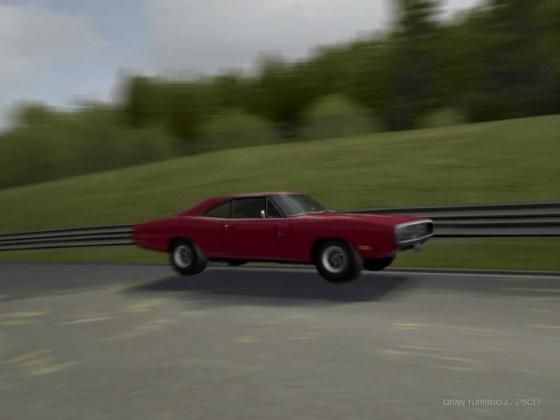
|
| ....go get doze Duke Boys! |
----------------EXTERIOR / HISTORY-------------------
Anyone remember the Dukes of Hazzard? The other day I was watching some cable TV and
it was on. This show used to follow The Incredible Hulk every Friday night at 9, and seemed like one of the greatest
shows EVER when I was 13. In case you're not familiar: think plenty of bad acting, insipid plots, and who could forget
Daisy Duke in her cut-off shorts and halter top? Yummm.
Anyways, each show was basically the same: Bo & Luke Duke
were these two brothers or cousins or something, they lived somewhere in the south with their Uncle Jesse and the long-legged
Daisy. I forget if Daisy was their sister or cousin. Who cares. Each week, Bo & Luke would get into some sort of a jam
with the police, yet they'd always manage to evade serious jail time no matter what. Sherriff Boss Hogg and deputy Roscoe
P. Coltrane represented the bumbling law force along with some other cop, and at least once per show you'd hear them say
“Go git doze Duke boys!”
...which they never did, and if they actually did catch them, Bo & Luke would (without fail)
get off on a technicality every time, usually with some help from their bubba-ish uncle. Uncle Jesse knew the law better than
the actual law did -- despite looking like the kind of dude who you'd expect to have an everclear still hidden on his property.
Sometimes, all it would take for the Duke boys to escape to freedom as they were chased by Roscoe would be to simply drive
into a neighboring county where the police couldn't hold jurisdiction. So much for realism.
But forget all that, the
main reason I watched the show (other than to fantasize about Daisy) was to see the General Lee, an
orange-red 1969 or 1970 Dodge Charger with a southern Dixie flag painted on its top. Alas, network television had found yet
another way to send mixed messages to us kids. The rest of the show (whatever the plot was, whatever the dialogue
was) didn't matter. I yearned for that damn car to show up and do one its stunts! Um, I also yearned for a scene
of Daisy bending over so I could finally see some cheek.
...Hey...I was THIRTEEN!!!
So as you've probably surmised, the best part of the show was this Charger
being chased around the countryside, scrambling over dirt roads, and flying thru the air with unearthly grace. I once read
that the show kept several of these Dodges around since they were constantly being beat up. I read somewhere else (Wikipedia,
probably) that a car was usually destroyed each and every episode. And there were five seasons of the Dukes of Hazzard;
which means...that's a lot of Chargers! In the final season of the show, they could no longer use real Chargers...Wikipedia's
info tells us that they used "miniatures" instead. Not sure exactly what that means. Anyways.
The cars on the D.O.H.
had a reinforced frame with welded doors to keep them from falling apart, but if you looked carefully, you'd occasionally
see their fenders buckle as they landed. All these memories I have from that dumb show are what makes the Charger
serious fun in Gran Turismo at a track like Seattle, Trail Mountain, or one of the off-road tracks, as it
slips & slides around.
The real Dodge Charger (not the wimpy front-drive car they made in the '80s, or the modern
sporty sedan) was produced from 1966 till 1974. After this, it was still around but no longer a performance-oriented machine,
thanks to gas and insurance prices. I'm not an expert but it seems the game car in GT2 is definately a '71 just as PD says
it is...earlier models had circular side-marker lamps. In GT4, PD has given us a 1970 model. We can tell because the side-marker
lamps are circular, and the grille is missing a center divider found on '69 models, but deleted in the following year. Good
job, Polyphony. GT5 has similar touches on its '70 440 R/T, except that the side markers are rectangular instead
of circular.
On the race tracks of the late '60s, the Charger and the Dodge Daytona were picked to compete against
Ford's Torino in NASCAR events. Though the Charger and the Daytona both won plenty of races, it was Ford who ultimately took
the championship during the first year in which the 200 mph Daytona debuted. But after this, the Daytona-Charger won so many
races it was banned in 1971 despite previously meeting all of NASCAR's requirements.
The Dodge Charger appears
in GT2, GT4, and GT5, and I couldn't help noticing some differences between these cars -- some major, some minor. The
price is one of the major ones. From 1999 (when GT2 was released) to 2004 (when GT4 was released) the Charger's price
rose about $50,000! This is realistic, as rare-optioned muscle cars have become more and more expensive
in real-life. Oddly, the Plymouth Superbird in GT4 (which is won as a prize) only "costs" $36,073 when traded
from memory card to memory card. Shouldn't the Superbird, which is rarer in real-life, not to mention a hell of alot
more outrageous, cost more than a Charger R/T? Ooops.
The 1971 car (GT2) also has Dodge's "vinyl top" option,
which is missing on GT4 & 5's 1970 models. Also, notice that the 1970 Charger in GT4/5 weighs 159 pounds less than the
1971 version in GT2. Again, this is probably realistic, although I don't have super-accurate research to back this up
at the moment.
Yeah, the Charger is heavy, and so it could use some pound-shaving; tho since there is so much power
available in this car, weight reductions aren't necessary to win most events that this car feels comfortable running (FR Challenge,
American events, Classic Car events, etc.).
There is no racing body (dammit) for GT2. An inexperienced GTer will have
problems controlling this beast, but I found it manageable even as I bounced up the staircase in the 100 mile Seattle
Enduro on sport tires. This car gives us a bit of a window in which it can be driven "safely"; hence that could be part of
why they used Chargers on the Dukes of Hazzard, but I'm just guessing here. The Charger is a 17 foot-long car with 7 feet
7 inches of overhang and will guarantee plenty of sliding and General Leeish behaviour, yet I found that there were times
in the race that I had to force drifts to get the cornering angle I wanted.
But that's for later.
| The Charger with "Top Banana" paint |
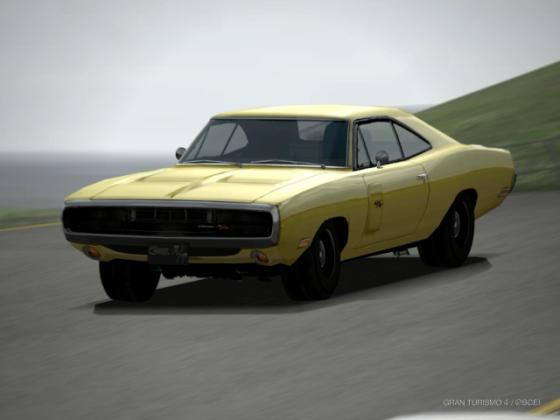
|
| ...meet the General Pee. |
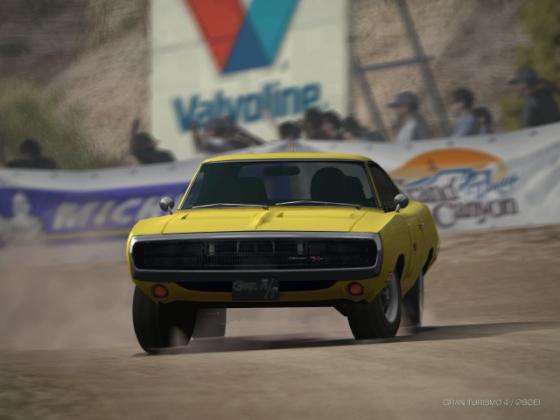
|
| it really has to go bad... |
----------------ENGINE / DRIVETRAIN----------------
There were several engines made for this model ranging from a 273-cid slant 6 (for those
on an early mission to save fuel, I suppose) to the gynormous 440 V8 that's in the game car. In 1970, Dodge replaced
the 4-barrel carburetor over the 440 with three Holley 2-barrel carbs; hence, the name nickname "6-pack" some of these cars
have in real-life.
In 1971, the 440 was slightly detuned from 390 horsepower to 385, as Chrysler prepared for an onslaught
of Government restrictions. Wow, now that's some detuning, good job guys! *chuckle* Take a spin in the 440, and first
thing you'll notice is it still had plenty of juice. The car can of course be ridiculously modified much further at the push
of a button. At tops, it'll put out 567 bhp @ 5,100 rpm with 594
ft-lbs. of torque at 4,600 in GT2, which is never actually needed during racing situations (unless you're going
head to head against your buddy or something). GT4 offers even more: 714 BHP @ 4,600
rpms and 843 ft-lbs. @ 3,200 with Stage 3 tuning, or 648 horses with 943! foot-pounds
of torque via supercharger. So far, I've found that this kind of power is something I've never needed for any GT4 race, but
it's cool that such power can be played with, don't you agree?
I did some driving with full-modified engines in GT4 (both the supercharger and Stage 3 NA tuning),
and surprisingly found them useful...if throttle control is kept conservative out of corners. These torque monsters will reliably
pull from a dead stop in 3rd gear, and at full steam will keep on pushing, despite the Charger's poor aero-profile. But unfortunately,
it's the car's aerodynamics that ultimately hurt. I know because recently I tried entering a Charger (as well as several other
muscle cars) in GT4's Like the Wind. No go.
Unlike the 426 Hemi, the 440 Six-Pack was standard in certain Charger models like the R/T found in our
games. The Hemi could be bought as an option, but since it cost about 1/3rd the price of a new Charger, few folks decided
to get it. For those of you unfamiliar: the Hemi has been used in Chrysler race cars since the '50s, and was built with varying
displacements. But it wasn't until the mid '60s that the 426 was actually dropped into a production car; hence, drag racers
sought it. A stock 440 could keep up with a stock Hemi till about 60 mph, but it was the Hemi which always passed the quarter-mile
first. In any event, you'll notice that the 440 likes to rev low and slow ... producing peak power at 4,500 rpm, a full 500
rpm lower than the 426 Hemi.
Keep this in mind when setting up your fully-modifyable racing tranny (which you eventually WILL
need); this is done to extract peak midrange power. In GT2, you'll never need to get within 1,000 rpm of the redline.
Automatic trannys are a no-no in this game, lest the 440 steps too far outside its power-band and lose speed. Half
the reason all those muscle cars in the 100 mile Seattle Enduro and MC series are so slow is because they're not shifting
gears early enough, and are therefore losing time as they get far past their peak power zones.
GT4 cars have a lower
redline of just 5,100 rpms. Useable power can be extracted realisitically with either automatic or manual trannies in GT4.
When upgraded to a sports, semi-racing, or racing tranny, the ¼ mile bred 4-speed becomes an unrealistic 5 or 6-speed, but I
like pretending the higher gears aren't there. Since stock gearing is extremely short (and it shows since in either game,
Chargers won't be able to top 130 mph) close gearing seems an odd option we'll never need. Why is it even available?
At the test track, the stock Charger engine in my test never hit its rev limit...by the time this
overhead-valve engine is revving in the mid-6,000s, it simply can't go any faster due to the car's blocky aerodynamics in
GT2. In GT4, the car wanted to get faster, but the stock short gearbox limited it to just 121 mph.
But off the mark? It stomps!
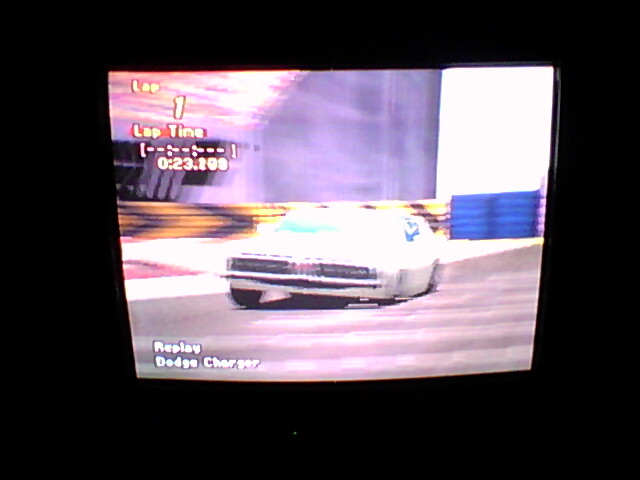
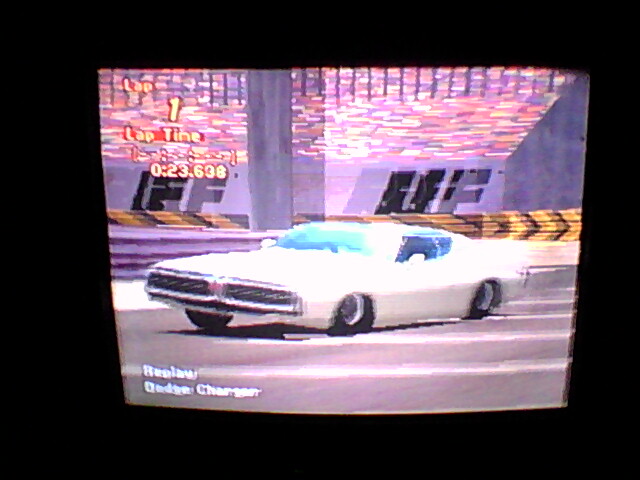
-------------------CHASSIS / HANDLING-------------------------
Trying to get suspension specs on the Charger turned up zilch when I originally wrote this
article in 2005. Muscle car websites are so obsessed with how much power an engine has, they rarely seem to discuss anything
else; so I couldn't find any info on tire size, suspension, or brakes right off the bat ....it took a lot of searching
(and 3 years) to polish off this dumb review properly, folks.
Notice (in GT4 & 5 especially) the giant tires for
the "R/T" (Road/Track .... not Road and Track) version of the Charger represented in this game. Despite their largish
size, they don't do a very good job. I think we all know what we're in for here. And if you don't know, uh.... This is not
a good-handling car, after all, BUT it's not a hopeless cause either.
There isn't a flaw known to drivers that you possibly won't get experienced
now, in any game. Notice I haven't divided up the Handling section into GT2, GT4, and GT5. This is because the Charger is
one of those rare mobiles which suffers all of the following in any GT game it appears in. Understeer,
oversteer, fishtailing, excessive wheelspin, 4-wheel sliding, 180° spin-outs, ...in a Charger 440, you'll get all
the action, trust me. The only difference is (from game to game), the car may suffer a little more of this and a little
less than that. GT4's Chargers don't have as many issues with oversteer as GT5's for instance.
As for parts? All the
best are needed if you're really going to get this car from mediocre to "okay": brake balancer, limited-slip differential
(preferably the modifyable one), semi-racing or full-racing suspension, better tires...we might as well just buy all of it
now and get this chore out of the way. Would be convenient if PD gave us a 'Buy All Parts' package to get this done
in one step!
Personally, I was surprised that with better parts (but not the best parts) the Charger gets to
be a lot more manageble. I just finished the Seattle Enduro in GT2, for instance; battled and won against the Shelby Series
1 for most of the race....on sports tires and stock power (except engine balancing and port/polish), so that just goes to
show how unnecessary slicks are. But I'm sure they're useful in some other races or for novice drivers.
In GT4's
World Classic Car Professional races, I used a 1-way differential, semi-racing suspension, and medium sport tires (S2)
to get around, and only had major problems at Nürburgring. Despite the high-speed this car can attain, it does poorly with
minor clips into the grass, and those on-the-fly steering adjustments that the 'Ring demands. Which doesn't surprise
us at all, right?
With the suspension dialed-in and tires in place, the main problem becomes humongous weight transfer.
At the lightest, a Charger weighs-in at 3,368 pounds (GT2), and my car was Stage 2 (3,481)
in that Seattle Enduro, so most of my issues with it were due to the way it dived into turns under braking, leaving the rear-end
flopping around and ready to spin. The 440 is incredibly nose-heavy, which actually helped with front-end grip during braking,
yet caused some understeer under power, but not so much that cornering was killed altogether.
One of the
biggest flaws not mentioned so far will not occur in GT2, it starts to happen in GT4. It's this game's dreaded front-end "snap
back", which happens when the car gets into a slide (and note: this car is always looking for a slide!), the driver
countersteers to correct this, and now the front-end snaps into the countersteer direction. And note: GT5
Chargers still suffer from this action as well! Maybe not as much as in GT4, and not as often, but this is still
something to consider at times.
Lots of cars as they made the switch from GT4 to GT5 notably do not exhibit
any snap back at all. This is great, because it means we can now corner or drift much more confidently in these cars. While
the Charger's snap back isn't as bad as it was in GT4, it's still something to occasionally consider. It can mess everything
up INSTANTLY if the driver makes a small mistake which at first doesn't even seem as though it'll be a mistake.
Basically:
If you're sliding, it may not be a good idea to always try and correct this slide. Sometimes it's better to wait instead for
the slide to end. But for those who are skilled, it's possible to now exploit these slides into drifting action. GT2 and GT5
cars drift the most readily..
So far as drifting goes, the Charger certainly has the ability to get sideways
under power, and is lots of fun. ;)
For those who are trying to get this car to behave, it's also possible to "twitch"
the Charger into turns but momentarily jerking its steering. This is done to get a better line. Rather than putting the
car into this huge, loud slide, twitching The General Lee into turns can cause the entire car to get a better line. I've
been doing this more and more in GT5, when I raced my Charger in both the Supercar Nostagia Cup and Muscle Car Race.
In
GT5 where non-ABS brakes can be used, take note that the Charger now gets into even more disasterous moments than it did in
earlier games, mostly because those rear brakes can start to lock up. Limited-slip decel action can help keep the R/T stable,
for those who prefer not to use ABS.
Off-road the Charger does surprisingly well...it orients itself
with less work, can travel sideways on dirt roads with no fear of front-end snapback (unlike on pavement). It
even can get ahead of 4-wheel drive competition that shows up at the Easy and Normal levels, and drives off-road
with minimal drama as long as you don't floor the gas every moment. Again, perhaps this has something to do with why this
car was chosen for the Dukes of Hazzard show...
As I race this car around, I
liked to think that I am one of the Duke boys, but instead of Roscoe P. Coltrane chasing me, faceless artificial intelligence
is on my tail in a Corvette Grand Sport perhaps.
I need to get out more. ;0
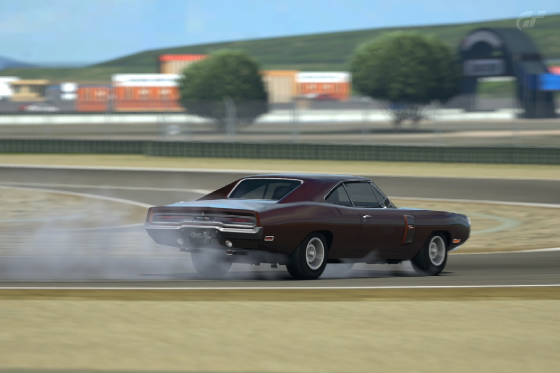
PROS---------------------------------------------------------
1). Typical muscle-car acceleration. Gut wrenching low-end torque will guarantee you'll never need
to redline this baby in GT2. Since the redline is 900 rpms lower in GT4 & 5, this of course changes.
2). More power
upgrades from MOPAR than we'll ever need. They're affordable to most drivers, too.
3). In Gran Turismo 2, PD gave us
the vinyl top version of the Charger. Yaaah! Woulda been nice if the racing body was an option...perhaps with an R/T or Super
Bee look. In any event, there is an overload of available colors to buy your Charger in either GT2 or GT4. Plum Crazy (unofficially
known as "Statutory Grape"), Go Mango!, Top Banana, Hemi Orange and other over-the-top names are offered along with the usual
reds, blacks, greens, silver, tans, beige, blues....Hey, it was the sixties!
4). At $21,080, this is one of the cheaper
muscle cars of GT2.
5). Even tho this car is hopelessly big, there's a fun factor we can get from a Charger as it slides
around that just isn't the same in an STi, Evo, Audi, Skyline GTR, or other well-handling machines.
6). One of
the most photogenic cars of GT4/5. Seriously, it's hard to get a bad shot when using Photomode that you'll want
to delete. Even with GT2's poor graphics, the Charger stands out and turns heads every time.
7). Stage 1 weight reduction
removes over 400 pounds in GT4.
8). Great sounding V8 from idle to peak RPMS.
9). Surprisingly
good off-road. All that's missing are some police cars chasing us around.
CONS------------------------------------------------------------
1). Pro #5 up
above = Con #1 here for some folks, who won't be able to handle the grotesque behaviour!!! Every negative handling
trait one can think of is embodied in this car.
2). Too much front & rear overhang on the body that look cool but
cause lots of diving, rolling, and fishtailing.
3). Soft springs, even with a semi-racing suspension in place.
4).
You will need the full package of suspension, brake, LSD, and transmission upgrades unless you're experienced. Engine parts
are pretty much secondary if you're good on the tracks.
5). Weight. Stage 3 reductions won't clear 3,200 pounds in
GT2, or 3,017 pounds in GT4. No racing body available in GT2.
6). Poor braking response, despite the fact that the
real-life Charger 440 had “heavy duty” brakes and suspension parts. This car is much more suited to going than
it is to stopping.
7). Poor top speed despite those 385 horses. This is mostly due to low power availability
over @5,500 rpm, poor aerodynamics, and the way the transmission is geared when stock.
8). Stock suspension is not
up to the task at all, except maybe for NASCAR-style oval racing at Super Speedway!
9). For those of you who'd want
to take this car to the Compact Car series, you're out of luck! J/k. My point is that the awesome power in the Charger limits
its chance to race in a bunch of GT2 events.
10). Fuel mileage only a gas station attendant could love.
11).
Pricey in GT4 and 5.
12). Also, can be hard to find in GT5's used car lot.
13). Sports, semi-racing, and
full-racing mufflers often sound weak and very un-V8 like, depending on game and part.
Published:
May 30th, 2005
Edited for GT4 content: ???
Edited for GT5 content: December 2, 2011
|



